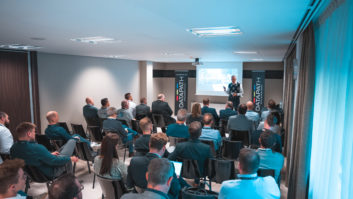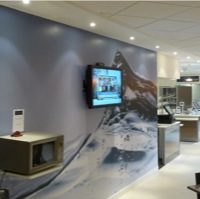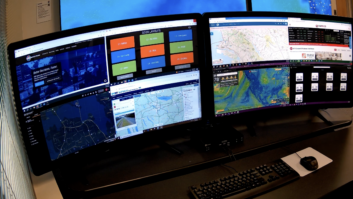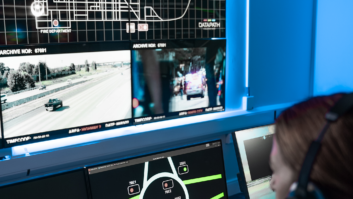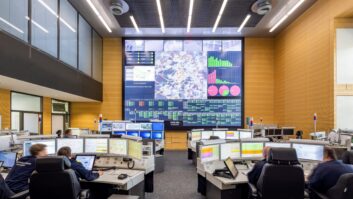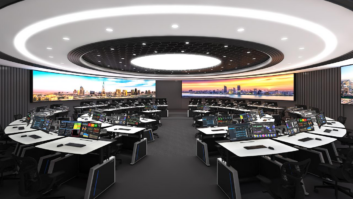
Due to the nature of the work being done in control centres, solutions, first and foremost, need to be easy to use as any human error can result in major problems. However, the simplicity of operation from the solutions sought is in stark contrast to the inherent complexity of control rooms systems, and the associated knowledge requirement, which continues to increase.
“Accounting for technology developments in terms of control room infrastructure, such as the migration to digital video and advances in computing devices, can often involve great complexity in terms of combining all these requirements to provide flexible information display and user access,” says Nicolas Jaud, product marketing manager at Aten UK. “Implementing solutions in control rooms requires a sound knowledge of current – and future – developments in not only network connectivity and multiple IT system management, but also in how the integration of computer operations/control and AV systems can account for the need for essential decision-related content being available in remote spaces.”
As networked AV solutions have emerged, traditional matrix switchers for signal management in control rooms have fallen out of favour. In part, this is due to the ever-increasing number of signals that control rooms are managing, as well as the fact that facilities receive more data than ever before. “These high-density installations need solutions that efficiently transport AV and control signals at low bitrates, and maximise the available bandwidth by putting more streams on the network,” explains Caroline Injoyan, business development manager for Matrox Graphics.
Jaud agrees, and elaborates: “What is needed are control room solutions that provide such a networked distributed collaboration system, ones that take into account the complexities of signal distribution, the connectivity of both physical and virtual servers, data visualisation and professional videowalls, and intuitive workflows and operator controls.”
Another development, mirrored by the wider industry, is the move to higher resolutions. “Video feeds are becoming high resolution with 4K commonplace and expected to be the standard in the future,” states Manuel Greisinger, head of sales at IHSE. “The ability to handle high resolution with no delay or artefacts is crucial.”
Darren Allen, control room business development manager EMEA at Adder, notes the importance of avoiding delays: “From receiving data and information from a variety of sources, to analysing it and making mission-critical decisions; any delay, be it mere seconds or minutes, has the potential to negatively impact operations.
“Making sure these environments remain productive and successful comes down to their design. Of course, staff, technology and operations play a key role, but the layout creates the right foundation for all of the other components to fit into place.”
Set-up and operation
The technologies that have had the biggest impact on command and control rooms in recent years are KVM and the move to IP infrastructures. But how have they changed how control rooms are set up and operated?
“Traditionally control rooms would house banks of computers and displays,” says Allen. “However, today the aim is for a room that is smart, uncluttered and comfortable for operators so they can concentrate on the tasks in hand.
“The obvious benefits of moving to IP are increased flexibility and scalability – that is, the ability to quickly, easily and cost-effectively scale infrastructure in line with business growth. It’s ease of use and integration is one of the main drivers for implementation, particularly as skills have evolved. In addition, it is easier to use IP-based technology than it is to use proprietary systems. And, of course, with the cost of networking equipment dropping so significantly, IP is an attractive proposition.”
“Control rooms are no longer limited by the maximum distance an analogue signal will travel from the rack room,” says Daniel Hinton, Argosy’s broadcast and communications regional manager. “Using IP networking, the control room can be located where it is convenient for the operation – which could even be off-site. We have recently seen customers build a main control room on-site, with a smaller control room off the premises for redundancy. As well as disaster recovery, this means for instance that an international company can have 24-hour access and control, with different time zones logging in to provide continuity.”
Jochen Bauer, marketing director at Guntermann & Drunck, adds: “Just think of remote tower concepts of air navigation services, which have become very popular in recent years. Numerous air navigation services operate remote towers and monitor approach, departure and the traffic on the airport apron from a remote control room with no direct view of the airport.”
Samuel Recine, director of sales – America and Asia Pacific at Matrox Graphics, is effusive on the impact of the move to IP infrastructures. “The move to low-bitrate, standard IP infrastructures has been nothing short of tectonic in the increased level of demand for our KVM products,” he says. “While we are still growing our relationships for our fibre optic deployments, the new low bitrate category cable deployments over standard IP means our sales performance is not just growing but doubling and tripling.”
Space limitations
As the available space in many command centres has continued to dwindle, KVM solutions have been even more widely deployed as it allows bulky computer equipment to be removed from the operator’s local environment and safely stored away in technical rooms.
“Increasingly, organisations are looking to combine numerous control rooms into a single environment,” says Allen. “Consequently, KVM solutions allow remote access to computers or other applications, so these can be transferred to a different room, freeing up more space in the main hub.
“IP-based KVM solutions enable organisations to move all physical computers away from the working environment and into a dedicated, secure external room such as a rack-mounted server room and separating secure networks from unsecured networks, a process referred to as ‘air gapping’.”
Hinton adds: “Control rooms should be designed for the logistics of the operation, not for the convenience of the technology. That means providing comfortable working space for the operators required, and putting the equipment they need to operate under their hands.
“This seems like an obvious requirement, but it is only through powerful, high bandwidth networked KVM that it has become practical.
“Modern KVM technology not only puts control of all devices on a single workstation, it allows multiple high resolution displays on a monitor wall, and of course it contributes to the environment of the control room by eliminating noisy and heat-generating equipment.”
However, Injoyan disagrees with the idea that a central videowall is the way to go: “When control room spaces are limited, personal videowalls at operator stations are favoured over a single, central, large-scale videowall. The interoperability and integration of IP KVM solutions with these videowall controllers becomes necessary for operators to easily share content on the videowall and create digital spaces for visualisation and collaboration. Supporting standards-based technologies facilitate the integration of KVM and videowall technologies in the same environment.”
The fact that the consequences of human error in these environments can be very serious – ergonomics, unsurprisingly, is high on the list of priorities when fitting out facilities. “A more ergonomic design results in a better workflow and device management,” explains Jaud.
“In addition to extending hardware lifecycle and performance reliability by locating machinery away from operators in ideal environmental conditions, it is also imperative to consider the operators themselves. Control and peripheral equipment should be located optimally and displays should be angled for comfort and ease of viewing.
“More importantly, access to controls should be intuitive in order to create an environment that enables operators to stay alert and in control so that when incidents do occur, responses can be instant and appropriate resources can be immediately deployed. For these reasons, operator workspace and control solutions that enable multiple computer desktop workflows are the way forward.”
Integrator influence
A fast-changing and constantly adapting environment inevitably presents a major opportunity for integrators well versed in the market. “By embracing the latest technologies, including KVM solutions, AV integrators have become increasingly influential in control room environments as they’re able to create installations that not only make life easier for operators, but increase overall wellbeing and efficiency,” comments Allen.
“Previously it was the security integrators that tended to lead on such projects, but AV seems to be leading more and more in innovating and project leadership. AV technology has essentially enabled users within the control room environment to do more with less, and so naturally the technology itself is becoming a central part of day-to-day activities within these environments.”
Incorporating new technology means an added layer of complexity is to be expected, as Hinton describes: “Now you have to understand network topology and switching design, to ensure there is certainty of bandwidth for all the monitoring and management required. Larger installations may require an independent network to provide the bandwidth. Copper may not provide the capacity, and you will need to install a fibre backbone.”
Conversely, Bauer believes the integrator’s job may have become slightly easier thanks to technology developments. “Today more than ever, integrators can build control rooms with mainly ergonomics and design in mind, since they no longer have to include the computer equipment, which KVM systems help house in safe and space-saving technical rooms. This means that they no longer have to design the control room with regards to technical aspects such as number of computers, background noise, heat emission and ventilation concepts and are thus able to focus on ergonomics and user-friendliness.”
www.adder.com
www.argosycable.com
www.aten.com
www.gdsys.de/en
www.ihse.com
www.matrox.com/graphics/en
